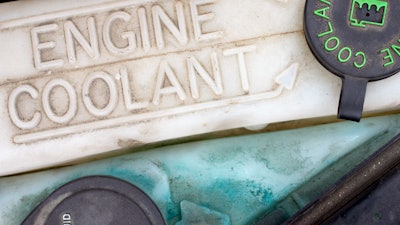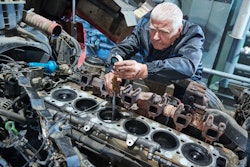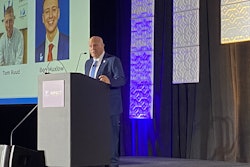
Few product categories have a greater impact on total cost of ownership than coolant. Essential for engine temperature management and longevity, improper coolant maintenance degrades engines, prohibits optimal performance and can eventually lead to catastrophic engine overhauls.
That’s why coolant companies are so vigilant in educating truck owners and parts and service professionals about formulations and the impact the chemical makeup can have on a fleet’s total cost of ownership.
Topping off a cooling system might get a truck to its next stop, but to make a habit of it is just asking for trouble. Especially if each top-off features a different coolant formulation.
“There are general groups of coolant that each have similar chemistry, but no two coolants are exactly the same,” says Brad Jordan, technical services manager for coolants at Shell. “When a truck has been filled with one coolant and you top it off with another one, you may be diluting each coolant due to different formulations.”
[RELATED: Repair labor rates climbing, driving technician pay raises]
Most trucks on North American roadways in 2023 are overwhelmingly filled with organic acid technology coolants, or OATs. Jordan says OAT formulations supplanted conventional inorganic acid technology (IAT) coolants more than a decade ago and are now factory-fill on nearly every new truck. Jordan says IAT coolants served the trucking industry well for decades, but periodically required supplemental coolant additives (SCA) to maintain performance levels. OATs do not require those periodic additives, which reduce downtime without impacting engine performance.
 New medium- and heavy-duty trucks produced in North America are factory filled with organic acid technology (OAT) coolants, which do not require supplemental coolant additives while in use.
New medium- and heavy-duty trucks produced in North America are factory filled with organic acid technology (OAT) coolants, which do not require supplemental coolant additives while in use.
“OATs have very long service lives,” Jordan says. “With our [OAT] nitrite-free coolant, you really don’t have to do anything but check the freeze point twice a year.”
Truck owners who purchase a vehicle that was factory-filled with an OAT should continue operating that coolant for as long as they have the vehicle. New OAT coolants are developed in partnership with engine manufacturers to provide optimum protection to the components found in new engines, says Prestone Vice President of Technology Colin Dilley.
“We work with OEMs through direct conversations, developments and fleet tests to develop solutions to get maximum uptime for heavy-duty vehicles. We develop in partnership proprietary test rigs to assess coolants. We also work with the industry to understand their needs,” he says. “Prestone understands that engines are changing. We don’t just put new claims on old coolants, we develop new technology platforms for premium products that offer a distinct advantage.”
That’s why topping off with any random coolant can be so troublesome. Mixing coolants doesn’t just weaken their efficacy, it also can increase contamination and corrosion within an engine.
“Stress on coolant has increased significantly as more components are coolant-cooled. Given this stress, any deterioration of the cooling system reduces its ability to cool the engine sufficiently. Newer trucks need new technology coolant,” says Dilley.
[RELATED: Understanding differences in coolant types key to maximizing engine protection]
Additionally, Jordan notes while OEMs have converted to OAT coolants there is not yet a consensus regarding nitrite or nitrite-free solutions.
“The evidence is pretty compelling that going with an OAT [coolant], whether with nitrites or nitrite free is the way to go,” he says. “Customers who are buying the traditional fully formulated [IAT] coolants are looking at a price point.”
In the aftermarket, the experts says that’s something to consider when dealing with customer inquiries. Dilley says there’s usually not a downside to sticking with a factory-filled coolant throughout a vehicle’s life cycle “if proper maintenance is followed.” The impact of a poor coolant selection is ultimately far more costly than a more expensive formulation up front.
“There are some very cheap, very poor quality coolants out there. A bad coolant will not provide protection to cavitation corrosion and that will result in penetration of the wet sleeve, and potentially destroy the engine,” says Dilley.
Jordan adds if a customer is committed to using a different coolant, they should follow the recommendation of their coolant provider when making the swap.
He says when switching a single truck or two, it’s best to just flush the whole system and refill with the new coolant. If it’s a larger fleet, he says Shell has a coolant conversion product that can be used to gradually transition units from one formulation to another. He says the conversion product has a concentration of additive chemistry that enables it to withstand the challenges that occur with coolant mixing.
“If you’re going to change a coolant you have to be aware of certain things,” he says. “We advise [customers] look at total cost of ownership. The upfront price for OAT coolant may a little higher, but over the long run, it becomes a clear winner.”












